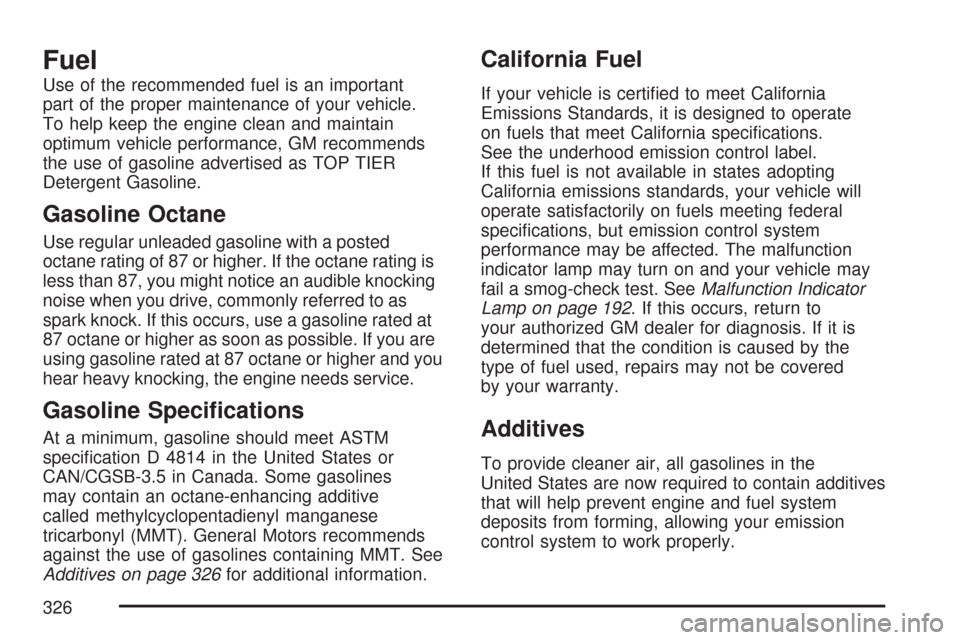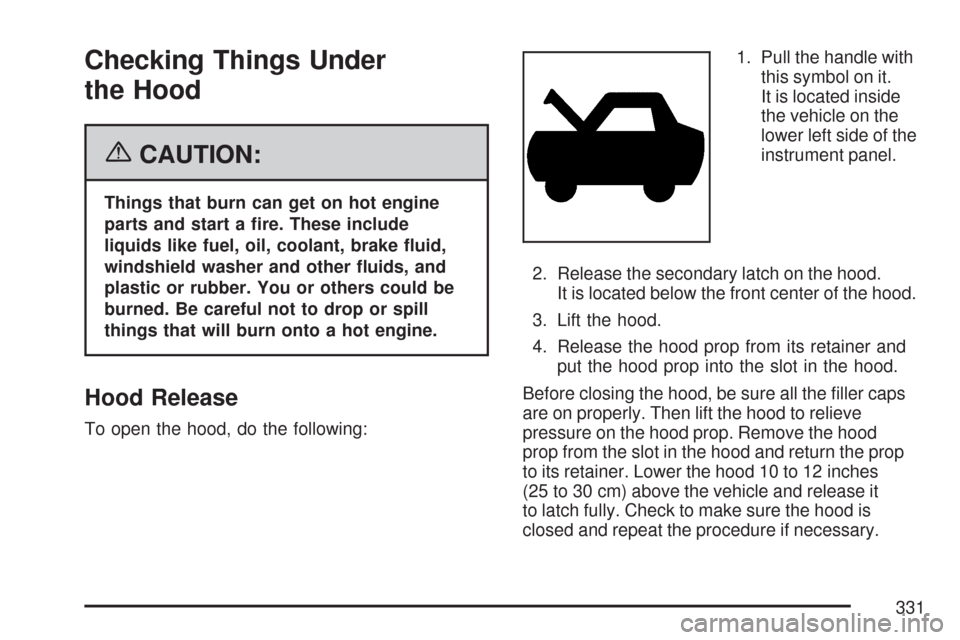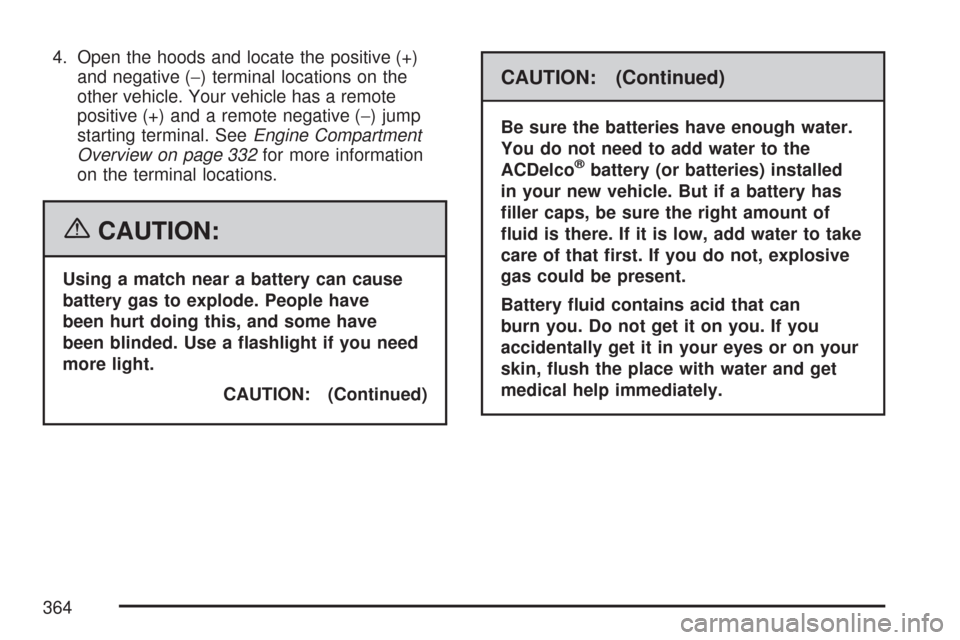Page 123 of 496

Engine Coolant Heater
Your vehicle may have this feature.
In very cold weather, 0°F (–18°C) or colder, the
engine coolant heater can help. You will get easier
starting and better fuel economy during engine
warm-up. Usually, the coolant heater should
be plugged in a minimum of four hours prior to
starting your vehicle. At temperatures above 32°F
(0°C), use of the coolant heater is not required.
Your vehicle may also have an internal thermostat
in the plug end of the cord. This will prevent
operation of the engine coolant heater when the
temperature is at or above 0°F (−18°C) as
noted on the cord.
To Use the Engine Coolant Heater
1. Turn off the engine.
2. Open the hood and unwrap the electrical
cord. The cord is located in the engine
compartment behind the underhood fuse block
on the driver’s side of the vehicle.
3. Plug it into a normal, grounded 110-volt AC
outlet.
{CAUTION:
Plugging the cord into an ungrounded
outlet could cause an electrical shock.
Also, the wrong kind of extension cord
could overheat and cause a �re. You
could be seriously injured. Plug the cord
into a properly grounded three-prong
110-volt AC outlet. If the cord will not
reach, use a heavy-duty three-prong
extension cord rated for at least 15 amps.
4. Before starting the engine, be sure to unplug
and store the cord as it was before to keep it
away from moving engine parts. If you do
not, it could be damaged.
How long should you keep the coolant heater
plugged in? The answer depends on the outside
temperature, the kind of oil you have, and
some other things. Instead of trying to list
everything here, we ask that you contact your
dealer/retailer in the area where you will be parking
your vehicle. The dealer/retailer can give you
the best advice for that particular area.
123
Page 326 of 496

Fuel
Use of the recommended fuel is an important
part of the proper maintenance of your vehicle.
To help keep the engine clean and maintain
optimum vehicle performance, GM recommends
the use of gasoline advertised as TOP TIER
Detergent Gasoline.
Gasoline Octane
Use regular unleaded gasoline with a posted
octane rating of 87 or higher. If the octane rating is
less than 87, you might notice an audible knocking
noise when you drive, commonly referred to as
spark knock. If this occurs, use a gasoline rated at
87 octane or higher as soon as possible. If you are
using gasoline rated at 87 octane or higher and you
hear heavy knocking, the engine needs service.
Gasoline Speci�cations
At a minimum, gasoline should meet ASTM
speci�cation D 4814 in the United States or
CAN/CGSB-3.5 in Canada. Some gasolines
may contain an octane-enhancing additive
called methylcyclopentadienyl manganese
tricarbonyl (MMT). General Motors recommends
against the use of gasolines containing MMT. See
Additives on page 326for additional information.
California Fuel
If your vehicle is certi�ed to meet California
Emissions Standards, it is designed to operate
on fuels that meet California speci�cations.
See the underhood emission control label.
If this fuel is not available in states adopting
California emissions standards, your vehicle will
operate satisfactorily on fuels meeting federal
speci�cations, but emission control system
performance may be affected. The malfunction
indicator lamp may turn on and your vehicle may
fail a smog-check test. SeeMalfunction Indicator
Lamp on page 192. If this occurs, return to
your authorized GM dealer for diagnosis. If it is
determined that the condition is caused by the
type of fuel used, repairs may not be covered
by your warranty.
Additives
To provide cleaner air, all gasolines in the
United States are now required to contain additives
that will help prevent engine and fuel system
deposits from forming, allowing your emission
control system to work properly.
326
Page 331 of 496

Checking Things Under
the Hood
{CAUTION:
Things that burn can get on hot engine
parts and start a �re. These include
liquids like fuel, oil, coolant, brake �uid,
windshield washer and other �uids, and
plastic or rubber. You or others could be
burned. Be careful not to drop or spill
things that will burn onto a hot engine.
Hood Release
To open the hood, do the following:1. Pull the handle with
this symbol on it.
It is located inside
the vehicle on the
lower left side of the
instrument panel.
2. Release the secondary latch on the hood.
It is located below the front center of the hood.
3. Lift the hood.
4. Release the hood prop from its retainer and
put the hood prop into the slot in the hood.
Before closing the hood, be sure all the �ller caps
are on properly. Then lift the hood to relieve
pressure on the hood prop. Remove the hood
prop from the slot in the hood and return the prop
to its retainer. Lower the hood 10 to 12 inches
(25 to 30 cm) above the vehicle and release it
to latch fully. Check to make sure the hood is
closed and repeat the procedure if necessary.
331
Page 332 of 496
Engine Compartment Overview
When you open the hood on the 2.9L engine (3.7L engine similar), you will see the following:
332
Page 348 of 496

Radiator Pressure Cap
Notice:If the pressure cap is not tightly
installed, coolant loss and possible engine
damage may occur. Be sure the cap is
properly and tightly secured.
SeeEngine Compartment Overview on page 332
for more information on location.
Engine Overheating
A coolant temperature gage is on the instrument
panel. SeeEngine Coolant Temperature Gage
on page 191.
The air conditioning might stop working if the
engine is too hot. This is normal and helps
cool the engine.
If Steam Is Coming From Your Engine
{CAUTION:
Steam from an overheated engine can
burn you badly, even if you just open the
hood. Stay away from the engine if you
see or hear steam coming from it. Just
turn it off and get everyone away from
the vehicle until it cools down. Wait until
there is no sign of steam or coolant
before you open the hood.
If you keep driving when your engine is
overheated, the liquids in it can catch �re.
You or others could be badly burned.
Stop your engine if it overheats, and get
out of the vehicle until the engine is cool.
Notice:If your engine catches �re because
you keep driving with no coolant, your vehicle
can be badly damaged. The costly repairs
would not be covered by your warranty.
348
Page 349 of 496

If No Steam Is Coming From
Your Engine
If you get an engine overheat warning but see
or hear no steam, the problem may not be
too serious. Sometimes the engine can get a
little too hot when you:
Climb a long hill on a hot day.
Stop after high-speed driving.
Idle for long periods in traffic.
Tow a trailer. See “Driving on Grades”
underTowing a Trailer on page 306.
If you get the overheat warning with no sign
of steam, try this for a minute or so:
1. In heavy traffic, let the engine idle in
NEUTRAL while stopped. If it is safe to
do so, pull off the road, shift to PARK (P)
or NEUTRAL and let the engine idle.
2. Turn off the air conditioning.
3. Turn on your heater to full hot at the
highest fan speed and open the windows
as necessary.If you no longer have the overheat warning,
you can drive. Just to be safe, drive slower
for about 10 minutes. If the warning does not
come back on, you can drive normally.
If the warning continues, pull over, stop, and
park your vehicle right away.
If there is still no sign of steam, idle the engine for
three minutes while you are parked. Push down
the accelerator until the engine speed is about
twice as fast as normal idle speed for at least
three minutes while you are parked. If you
still have the warning, turn off the engine and get
everyone out of the vehicle until it cools down.
You may decide not to lift the hood but to
get service help right away.
349
Page 364 of 496

4. Open the hoods and locate the positive (+)
and negative (−) terminal locations on the
other vehicle. Your vehicle has a remote
positive (+) and a remote negative (−) jump
starting terminal. SeeEngine Compartment
Overview on page 332for more information
on the terminal locations.
{CAUTION:
Using a match near a battery can cause
battery gas to explode. People have
been hurt doing this, and some have
been blinded. Use a �ashlight if you need
more light.
CAUTION: (Continued)
CAUTION: (Continued)
Be sure the batteries have enough water.
You do not need to add water to the
ACDelco
®battery (or batteries) installed
in your new vehicle. But if a battery has
�ller caps, be sure the right amount of
�uid is there. If it is low, add water to take
care of that �rst. If you do not, explosive
gas could be present.
Battery �uid contains acid that can
burn you. Do not get it on you. If you
accidentally get it in your eyes or on your
skin, �ush the place with water and get
medical help immediately.
364
Page 371 of 496
Headlamps
A. Low-Beam Headlamp/Daytime Running
Lamps (DRL)
B. High-Beam Headlamp
To replace one of these bulbs:
1. Open the hood. SeeHood Release on
page 331for more information.
2. Reach in and access the bulb sockets
from inside the engine compartment.3. Turn the bulb socket counterclockwise to
remove it from the headlamp assembly
and pull it straight out.
4. Unplug the electrical connector from the old
bulb by releasing the clips on the bulb socket.
5. Replace with a new bulb socket.
6. Plug in the electrical connector to the
new bulb socket.
7. Reinstall the new bulb socket into the
headlamp assembly and turn it clockwise
to secure.
8. Close the hood.
371